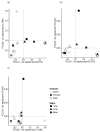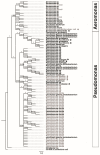Compositional Dynamics of Gastrointestinal Tract Microbiomes Associated with Dietary Transition and Feeding Cessation in Lake Sturgeon Larvae
- PMID: 36144474
- PMCID: PMC9500890
- DOI: 10.3390/microorganisms10091872
Compositional Dynamics of Gastrointestinal Tract Microbiomes Associated with Dietary Transition and Feeding Cessation in Lake Sturgeon Larvae
Abstract
Compromised nutritional conditions associated with dietary transitions and feeding cessation in the wild and during fish aquaculture operations are common and can impact growth and survival. These effects are especially prevalent during early ontogenetic stages. We quantified phenotypic and GI tract microbial community responses with an emphasis on protease-producing bacteria of lake sturgeon (Acipenser fulvescens) larvae, a species of aquacultural and conservational importance. To quantify responses associated with experimental food transition and feeding cessation, we performed a 36-day feeding experiment using two treatments: control and diet transition. However, larvae in the diet transition treatment failed to undergo transition and ceased feeding. Larvae in the diet transition treatment exhibited lower growth (total length and body weight) and survival than control larvae. Treatment had a greater effect than ontogenetic changes on taxonomic composition and diversity of the GI tract microbial community. Proteobacteria dominated the GI tract microbial community of the diet transition larvae whereas Firmicutes dominated the GI tracts of control larvae. Most of the 98 identified protease-producing isolates in both treatments were from genera Pseudomonas and Aeromonas: taxonomic groups that include known fish pathogens. Overall, failing to transition diets affected responses in growth and GI tract microbiome composition and diversity, with the later dysbiosis being an indicator of morbidity and mortality in larval lake sturgeon. Thus, microbiological interrogations can characterize responses to dietary regimes. The results can inform fish culturalists and microbiologists of the importance of dietary practices consistent with the establishment and maintenance of healthy GI tract microbiota and optimal growth during early ontogeny.
Keywords: aquaculture; diet transition; dysbiosis; feeding cessation; gut microbiome; high-throughput sequencing; lake sturgeon; microbiome; protease.
Conflict of interest statement
The authors declare no conflicts of interest.
Figures







Similar articles
-
Ecological and Ontogenetic Components of Larval Lake Sturgeon Gut Microbiota Assembly, Successional Dynamics, and Ecological Evaluation of Neutral Community Processes.Appl Environ Microbiol. 2020 May 5;86(10):e02662-19. doi: 10.1128/AEM.02662-19. Print 2020 May 5. Appl Environ Microbiol. 2020. PMID: 32169941 Free PMC article.
-
Changes in Lake Sturgeon Gut Microbiomes Relative to Founding Origin and in Response to Chemotherapeutant Treatments.Microorganisms. 2022 May 10;10(5):1005. doi: 10.3390/microorganisms10051005. Microorganisms. 2022. PMID: 35630448 Free PMC article.
-
Feeding Strategies for Adapting Lake Sturgeon (Acipenser fulvescens) Larvae to Formulated Diets at Early Life Stages.Animals (Basel). 2022 Nov 13;12(22):3128. doi: 10.3390/ani12223128. Animals (Basel). 2022. PMID: 36428356 Free PMC article.
-
Comparative study on the effects of different feeding habits and diets on intestinal microbiota in Acipenser baeri Brandt and Huso huso.BMC Microbiol. 2019 Dec 16;19(1):297. doi: 10.1186/s12866-019-1673-6. BMC Microbiol. 2019. PMID: 31842748 Free PMC article.
-
The Role of the Canine Gut Microbiome and Metabolome in Health and Gastrointestinal Disease.Front Vet Sci. 2020 Jan 14;6:498. doi: 10.3389/fvets.2019.00498. eCollection 2019. Front Vet Sci. 2020. PMID: 31993446 Free PMC article. Review.
Cited by
-
Tissue-specific transcriptomes reveal potential mechanisms of microbiome heterogeneity in an ancient fish.Database (Oxford). 2023 Aug 17;2023:baad055. doi: 10.1093/database/baad055. Database (Oxford). 2023. PMID: 37590163 Free PMC article.
References
-
- Werner E.E., Gilliam J.F. The Ontogenetic Niche and Species Interactions in Size-Structured Populations. Annu. Rev. Ecol. Syst. 1984;15:393–425. doi: 10.1146/annurev.es.15.110184.002141. - DOI
-
- Keeley E.R., Grant J.W.A. Prey size of salmonid fishes in streams, lakes, and oceans. Can. J. Fish Aquat. Sci. 2001;58:1122–1132. doi: 10.1139/f01-060. - DOI
-
- Olson M.H. Ontogenetic Niche Shifts in Largemouth Bass: Variability and Consequences for First-Year Growth. Ecology. 1996;77:179–190. doi: 10.2307/2265667. - DOI
-
- Gilliam J. Habitat Use and Competitive Bottlenecks in Size-Structured Fish Populations. Michigan State University; East Lansing, MI, USA: 1982.
LinkOut - more resources
Full Text Sources

